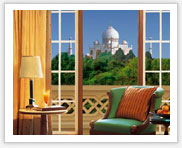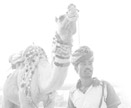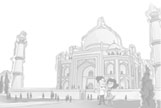
Home ››
Taj Mahal Tour Packages ›› Agra Tourist Attractions ›› Taj Mahal
Agra is famous as being home to one of the seven wonders of the world-the Taj Mahal. The architectural splendour of the mausoleums, the fort and the palaces is a vivid remainder of the mausoleums, the fort and the palaces is a vivid reminder of the capital in the 16th and early 17th centuries.
While its significance as a political centre ended with the transfer of the capital to Delhi in 1634 by Shah Jahan, its architectural wealth has secured its place on the international map.
Arond Agra Sightseeings
TAJ MAHAL
Taj Mahal Story
Shah Jahan, "The King Of The World"
Prince qhurram was the fifth son of emperor Jahangir. He was the man of extraordinary brilliance, a great diplomat, a warrior and a lover of art. Once Jahangir wrote, "In art, in reason, in battle there is no comparison between him and my other children". In the honor of his numerous victories Jahangir entitled him as "Shah Jahan", "The King of the World". After Jahangir's death all his sons quarreled for the thrown, after fighting for years Shah Jahan killed all his brothers under suspicious circumstances and became the emperor, besides him stood his queen, comrade and confidante.
Mumtaz Mahal "The chosen one of the palace"
Shah Jahan titled her "Mumtaz Mahal", "The chosen one of the palace". A rare found combination of beauty and brain. She was her husband's best friend and confidante. She would counsel him in the diplomatic matters. She too was a great lover of art.
 The End of the Fairy Tale
The End of the Fairy Tale
In 1631 Shah Jahan set up to berahanpur with his troops to subdue a rebellion, accompanied by Mumtaz Mahal Unfortunately during childbirth she suffered some complications and died. According to legend before dieing she extracted a promise from Shah Jahan that he would build a mausoleum as a tribute to their love.
The story of Taj Mahal begins Shah Jahan was obsessed to fulfill his wife's last wish. He invited the architects and artisans all over the world and planned for the building with absolute perfection. Taj Mahal was structured in Persian style combined with carvings of artisans called from Afghanistan and the garden designers from Kashmir. It took 22years to complete the Taj Mahal, a memento of love with the perfection of art. The carvings of Taj Mahal were decorated with very precious gemstones.
The story of Taj Mahal is unique in itself. It is an evidence that how the emotions and feelings are important to human life. The story of Taj Mahal is an example of devotion and faith. The story of Taj Mahal is a love story not found in papers but stands in the structural form. The story of Taj Mahal is rare.
History of Taj Mahal
The construction of this marble masterpiece is credited to the Mughal emperor Shah Jahan who erected this mausoleum in memory of his beloved wife, Arjumarid Bano Begum; popularly known as Mumtaz Mahal, who died in A.H. 1040 (A.D. 1630).
Her last wish to her husband was "to build a tomb in her memory such as the world had never seen before". Thus emperor Shah Jahan set about building this fairy tale like marvel.

The construction of Taj Mahal was started in A.D. 1632 and completed at the ended in 1648 A.D. For seventeen years, twenty thousand workmen are said to have been employed on it daily, for their accommodation a small town, named after the deceased empress- 'Mumtazabad', now known as Taj Ganj, was built adjacent to it.
Amanat Khan Shirazi was the calligrapher of Taj Mahal, his name occurs at the end of an inscription on one of the gates of the Taj. Poet Ghiyasuddin had designed the verses on the tombstone, while Ismail Khan Afridi of Turkey was the dome maker. Muhammad Hanif was the superintendent of Masons.
The designer of Taj Mahal was Ustad Ahmad Lahauri. The material was brought in from allover India and central Asia and it took a fleet of 1000 elephants to transport it to the site. The central dome is 187 ft. high at the centre.
Red sandstone was brought from Fatehpur Sikri, Jasper from Punjab, Jade and Crystal from China, Turquoise from Tibet, Lapis Lazuli and Sapphire from Sri Lanka, Coal & Comelian from Arabia and Diamonds from Panna. In all 28 kind of rare, semi precious and precious stones were used (or inlay work in the Taj Mahal.
The chief building material, the white marble was brought from the quarries of Makrana, in distt. Nagaur, Rajasthan. Copies of orders (farmans) issued to Raja Jai Singh, for the purpose by Shah Jahan, can be seen in the Taj Museum.
Taj Mahal's outer court, also known as
Jilo Khana, was formerly used both as a bazar and a caravansarai (Rest house). On the south-east and south-west comers are the tombs of Sirhindi Begum and Satiunnisa Khanum. The Taj has a jewel-like quality.
The shadow and light play demonstrates its many moods.
Some feel the Taj is best seen on a full moon night, others find it ethereal at dawn while some insist that it is sensuous at sunset.

 The story of Taj Mahal reflects the intensity of love. The fairy tale began when walking through the bazaar of Agra prince qhurram saw a girl. The girl was exceptionally beautiful. It was a love at first sight for both of them. After five years, on an auspicious day they were married and from that moment began the great epic of love.
The story of Taj Mahal reflects the intensity of love. The fairy tale began when walking through the bazaar of Agra prince qhurram saw a girl. The girl was exceptionally beautiful. It was a love at first sight for both of them. After five years, on an auspicious day they were married and from that moment began the great epic of love. 




